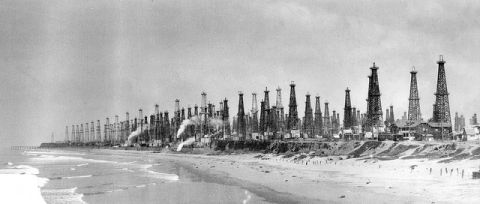Podcast: Play in new window | Download
Subscribe: RSS

What America will look like of the frackers have their way — and what Huntington Beach, California looked like in 1926. But according to the IEA’s World Energy Outlook, we shouldn’t be too concerned about what the frackers are going to be able to do. (Photo courtesy Orange County Archives)
The customarily cheery International Energy Agency (IEA), created to advise the member nations of the Organization for Economic Co-operation and Development (OECD), has taken a more somber tone in its latest annual World Energy Outlook released today. The agency dismisses the wildly hyped shale-oil and -gas “boom” in the United States as a band-aid on a malignant tumor, a temporary mask distracting the world from the pervasive illness afflicting its oil supply.
Just to keep up with expected growth in demand from developing countries (China, India, Brazil, to name the biggest ones), and to replace exhausted wells and fields, the IEA says will soon require the investment of nearly a trillion dollars a year. With the world price of oil unusually low and the cost of finding and delivering new sources of oil higher than it has ever been, there is simply no conceivable source for that kind of money.
In the good old days — a month ago — when oil was holding at $100 a barrel, the major oil companies were already cutting back drastically on their capital expenditures, or capex, which is their name for funding the search for new sources of oil. They were in effect giving up, because they had tripled their capex spending over the previous decade without significant results. An oil company that is not constantly finding new sources of oil is a company in liquidation. And that’s where they were before oil dropped below $80.
In the US oil patch they are still throwing confetti in the air and blowing tin horns about America’s fracking renaissance, insisting they can drive on through this little price deviation toward American energy independence, but in the background you can hear the thuds of oil derricks hitting the ground — being laid down by companies that cannot afford to keep them going. [See Shale Drillers Idle Rigs From Texas to Utah Amid Oil Rout, Bloomberg News Nov. 7. and Oil Below $80: The First Shoes Drop, Forbes Nov. 4.)
Extravagant predictions that other parts of the world will soon enjoy a boom in fracked oil, says the IEA report, are not realistic. With few identified shale-oil deposits, with environmental opposition at a fever pitch almost everywhere, and with most countries lacking infrastructure — pipelines, rail capacity, and the like — the fracking movement is failing to thrive anywhere else.
When one discounts the significance of the fracking boom and looks over the rest of the world’s oil supply, the prognosis gets grimmer, faster. Virtually every conventional oil field in the world is in decline, and many of them in the Middle East, North Africa and South America are in danger of disruption by social unrest. This is how the IEA sums it up:
“The global energy system is in danger of falling short of the hopes and expectations placed upon it. The short-term picture of a well-supplied oil market should not disguise the challenges that lie ahead as reliance grows on a relatively small number of producers.”
In other words: Brace for Impact.
When i was big into the anti-fracking movement in PA a few years back, i couldn’t believe people thought this industry was going to “save the day!” The reason being, of course, what do we do when THAT TOO runs out? i quit worrying about it and told the head person that we were wasting our time trying to convince state legislators to put a moratorium on fracking in the state because 1) it was already up and running, licensed and (cough, cough) “regulated” (and only slightly taxed after the citizens INSISTED on it), 2) the industry itself was finding that the wells played out in a relatively short time – so it wasn’t worth the investment to them and they’d HAVE to shut down (or lose more money every year), and 3) state legislators are captured by the monied interests (like the fracking industry) and are slow to change – since the industry was contributing to their re-election campaigns.
The anti-fracking movement went on without me, yet here we are!
The fracking industry is falling apart everywhere due to the EROEI problem and the fact that people are finally seeing that it leaves toxic waste in its place!
You can’t dump the fracking waste-water on the ground (or it will kill all the soil microbes and render the ground useless for growing anything – and dangerous to be around), you can’t dump it in streams and rivers (or it kills all the life there too) – AND it’s radioactive!
One more “minor” side comment is that fracking causes earthquakes and sinkholes to appear (documented on dutchsinse’s blog over the past few years).
Fracking is a desperate attempt by the monied interests to keep their party going (while everyone else suffers) for as long as possible. It seems that their time is almost up.
Thanks for this post Mr. Lewis.
The hard economic truths posed by the “EREOI problem” won’t stop the hired minions of the Koch Brothers from attempting to ram through the Keystone XL death funnel. Imagine what the economic outlook for fracking would look like if extractors had to bear their externalized costs.
Here are some informative basics about the reality of “fracking” from Chris Martenson’s Peak Prosperity website.